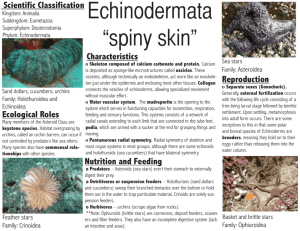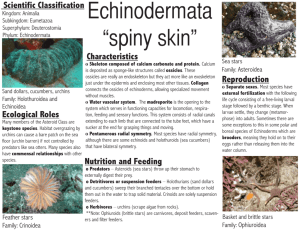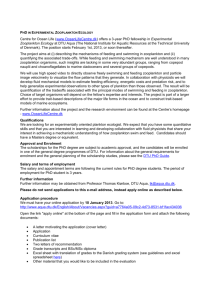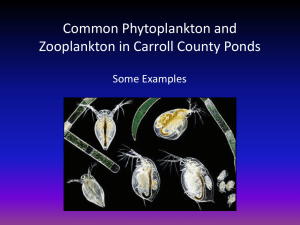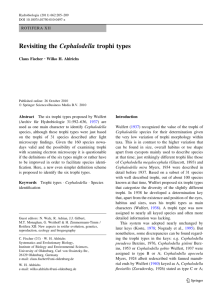Zooplankton Communities
advertisement
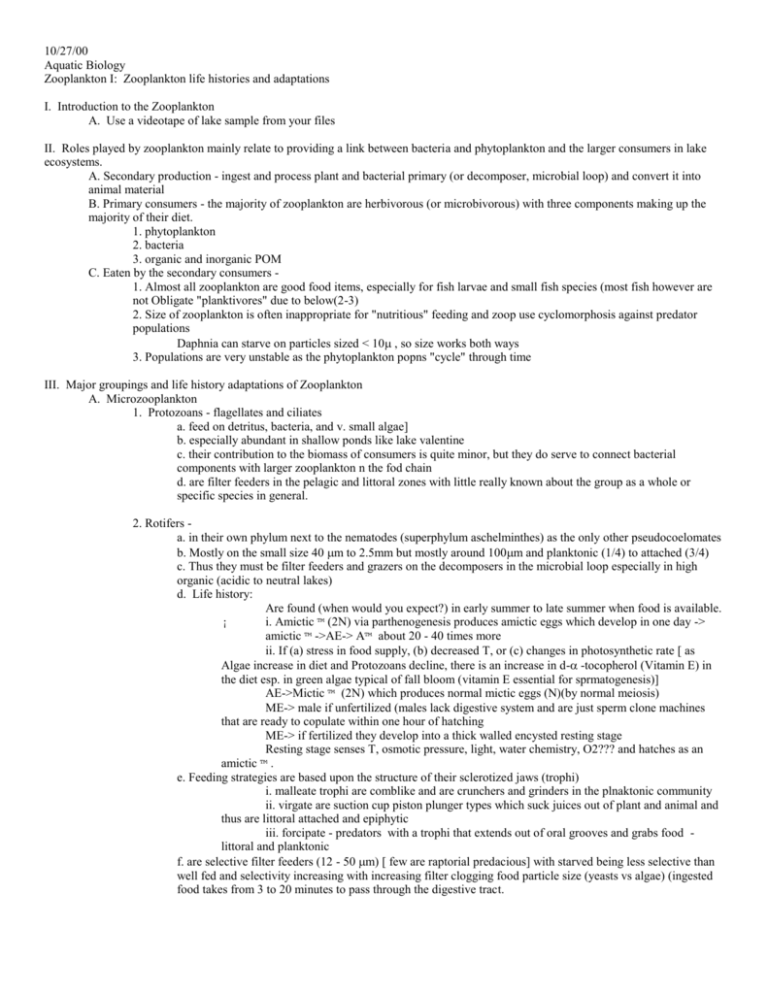
10/27/00 Aquatic Biology Zooplankton I: Zooplankton life histories and adaptations I. Introduction to the Zooplankton A. Use a videotape of lake sample from your files II. Roles played by zooplankton mainly relate to providing a link between bacteria and phytoplankton and the larger consumers in lake ecosystems. A. Secondary production - ingest and process plant and bacterial primary (or decomposer, microbial loop) and convert it into animal material B. Primary consumers - the majority of zooplankton are herbivorous (or microbivorous) with three components making up the majority of their diet. 1. phytoplankton 2. bacteria 3. organic and inorganic POM C. Eaten by the secondary consumers 1. Almost all zooplankton are good food items, especially for fish larvae and small fish species (most fish however are not Obligate "planktivores" due to below(2-3) 2. Size of zooplankton is often inappropriate for "nutritious" feeding and zoop use cyclomorphosis against predator populations Daphnia can starve on particles sized < 10 , so size works both ways 3. Populations are very unstable as the phytoplankton popns "cycle" through time III. Major groupings and life history adaptations of Zooplankton A. Microzooplankton 1. Protozoans - flagellates and ciliates a. feed on detritus, bacteria, and v. small algae] b. especially abundant in shallow ponds like lake valentine c. their contribution to the biomass of consumers is quite minor, but they do serve to connect bacterial components with larger zooplankton n the fod chain d. are filter feeders in the pelagic and littoral zones with little really known about the group as a whole or specific species in general. 2. Rotifers a. in their own phylum next to the nematodes (superphylum aschelminthes) as the only other pseudocoelomates b. Mostly on the small size 40 m to 2.5mm but mostly around 100m and planktonic (1/4) to attached (3/4) c. Thus they must be filter feeders and grazers on the decomposers in the microbial loop especially in high organic (acidic to neutral lakes) d. Life history: Are found (when would you expect?) in early summer to late summer when food is available. ¡ i. Amictic ™ (2N) via parthenogenesis produces amictic eggs which develop in one day -> amictic ™ ->AE-> A™ about 20 - 40 times more ii. If (a) stress in food supply, (b) decreased T, or (c) changes in photosynthetic rate [ as Algae increase in diet and Protozoans decline, there is an increase in d- -tocopherol (Vitamin E) in the diet esp. in green algae typical of fall bloom (vitamin E essential for sprmatogenesis)] AE->Mictic ™ (2N) which produces normal mictic eggs (N)(by normal meiosis) ME-> male if unfertilized (males lack digestive system and are just sperm clone machines that are ready to copulate within one hour of hatching ME-> if fertilized they develop into a thick walled encysted resting stage Resting stage senses T, osmotic pressure, light, water chemistry, O2??? and hatches as an amictic ™ . e. Feeding strategies are based upon the structure of their sclerotized jaws (trophi) i. malleate trophi are comblike and are crunchers and grinders in the plnaktonic community ii. virgate are suction cup piston plunger types which suck juices out of plant and animal and thus are littoral attached and epiphytic iii. forcipate - predators with a trophi that extends out of oral grooves and grabs food littoral and planktonic f. are selective filter feeders (12 - 50 m) [ few are raptorial predacious] with starved being less selective than well fed and selectivity increasing with increasing filter clogging food particle size (yeasts vs algae) (ingested food takes from 3 to 20 minutes to pass through the digestive tract. yeas t food FR (# eaten / rotifer/time) bacteria algae inrease in pseudotrocal s creening Food dens ity g. population growth rate is dependent thus on density and quality of food 16.4 microg/ml Popn growth rate Food dens ity Brachionus, Keratella, Asplanchna B. Mesozooplankton 1. CLADOCERA are early summer filter feeders that use their thoracic legs to set up a current and a "post-abdominal" spine as a toothpick to reject too large particles - the rate of food processing is thus determined by a. beating rate b. Width of carapace opening c. rate of PAS rejection - work by Gerritsen and Porter on feeding rates flow experiments shows that flow through the sieves is laminar and due to slow flow and water viscosity the sieve plate acts as a wall to the water --- so how do they feed selectively???? - styrene spheres of different sizes used on sp. Daphnia magna Ho: Sieve model: all particles less than 1.0m will pass through the filter = "slit size" - allowed animals to feed for 30 minutes and killed and examined the ingested particls (sizeed and counted) - Experiment 1 - untreated spheres - results smallest not fed on as much as expected and the larger were selected more than expected. - conclusion not a true passive sieving but selective grazing - Experiment 2 treated amide to neutralize the natural - charge and they filtered in proportion (observed = expected) - Conclusion surface properties determine capture efficiency for a given food item leading to neutral being captured more readily than charged particles Thus it is not size selection but surface chemistry selection - problems acid rain kills filter feeders as effects charges>>>>> Are parthenogenic most of the year A few 2N ™'s produce 1N eggs 2N ™ Amictic 2N eggs in "brood sac" Most 2N ™'s produce eggs which develop into 2N s Adult molts to release the young from the brood pouch - no free living larval stages Baby 2N ™ small adults, with many feeding & "food" sizes; 2 - 7 adult instars with new eggs in each instar sperm Copulation results in fertilized eggs in the brood sac which develops a thickened surrounding carapace making a resistant black egg case called the ephippium. These are especially formed as days get shorter (light) and then sink (or float) Eggs hatch with long days = light Developing into… 2. COPEPODS a. are sexual - Why? and ™'s 2 lateral egg sacs in cylopoid & 1 medial in calinoids Molt into copepodites and these molt 5- 6 more times increasing # appendages each molt Hatch into free swimming larvae called nauplii Resting eggs which diapause in the sediments The many sizes of young play very important roles in the food web. b. feeding Calenoid copepods make up 30% of the pelagic zooplankton (herbivorous) Algae are really low in concentration in most waters and so feeding becomes a major issue. Originally these were thought to be filter feeders but there were problems associated with this hypothesis. - must scan large amounts of water to get enough food to survive - must avoid the pull of gravity as they sink Solutions - Flow fields created with anterior appendages that optimally "sieves water -sampling is done via algal chemicals - gravity is used as an orientation device resulting in a species specific hunting for the best patches in which to feed - cruising vs feeding III. Filter feeding is a very distinct energy extraction technique A. Two separate processes 1. Filtering rate - the rate of extraction by filter feeding 2. Feeding rate - (includes FR above) - ingestion - take into the digestive system (what are associated problems) - digestion - breakdown and absorption - (what are problems with eating phytoplankton?) B. Study # 1 Rigler subjected crustacea to different densities of phytoplankton with the following results Filterin g rate 105 cells Filtering rate slows down as gut packing occurs. WE need to take apart the physiology of the organism to understand this phenomenon. # phytoplankton Why? 1. 2. 3. 4. 5. Thoracic limbs slow down Carapace narrows Rejection rate increases Is a size related phenomenon - increased size leads to increased energy needs - leads to increased need for higher feeding activity Process is internally regulated - why is this necessary? If full need to decrease feeding, but if in an optimal environment, without internal regulation the feeder would go on feeding and "waste" energy.


